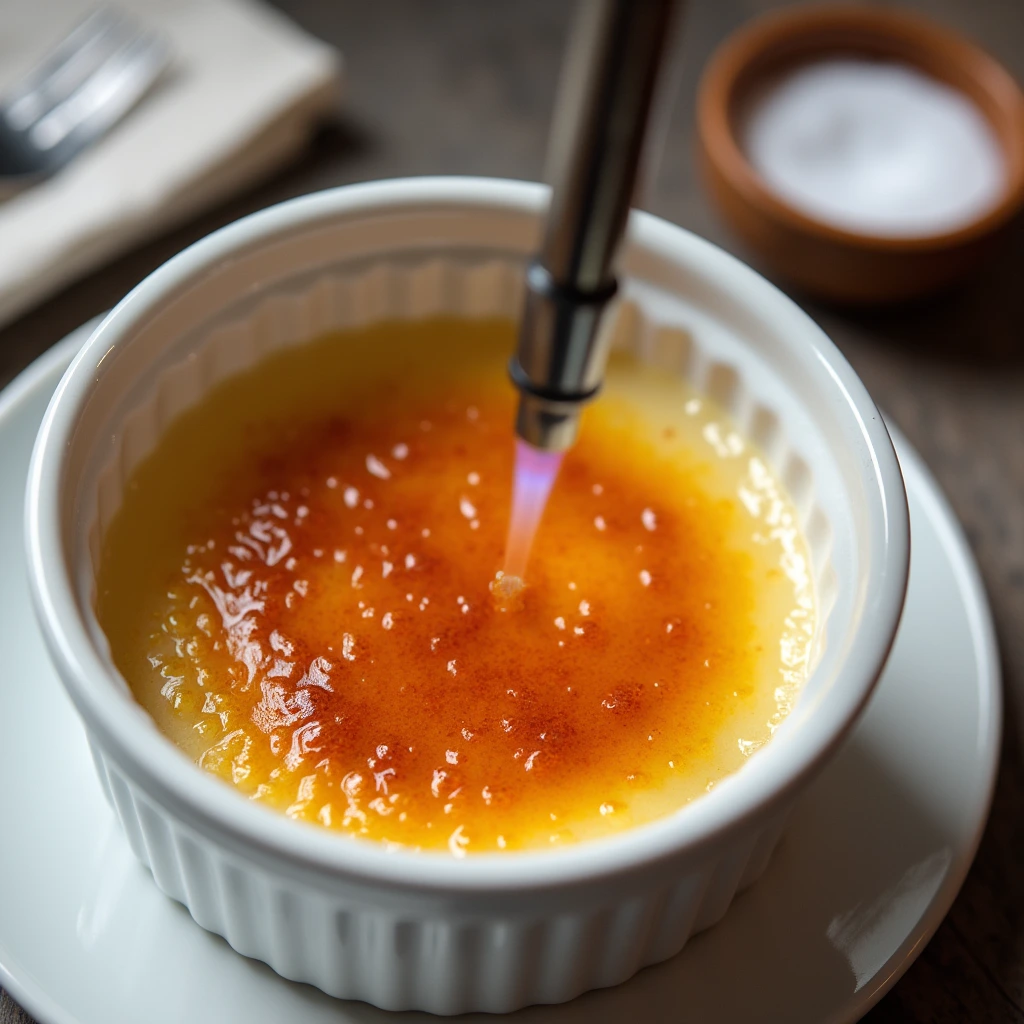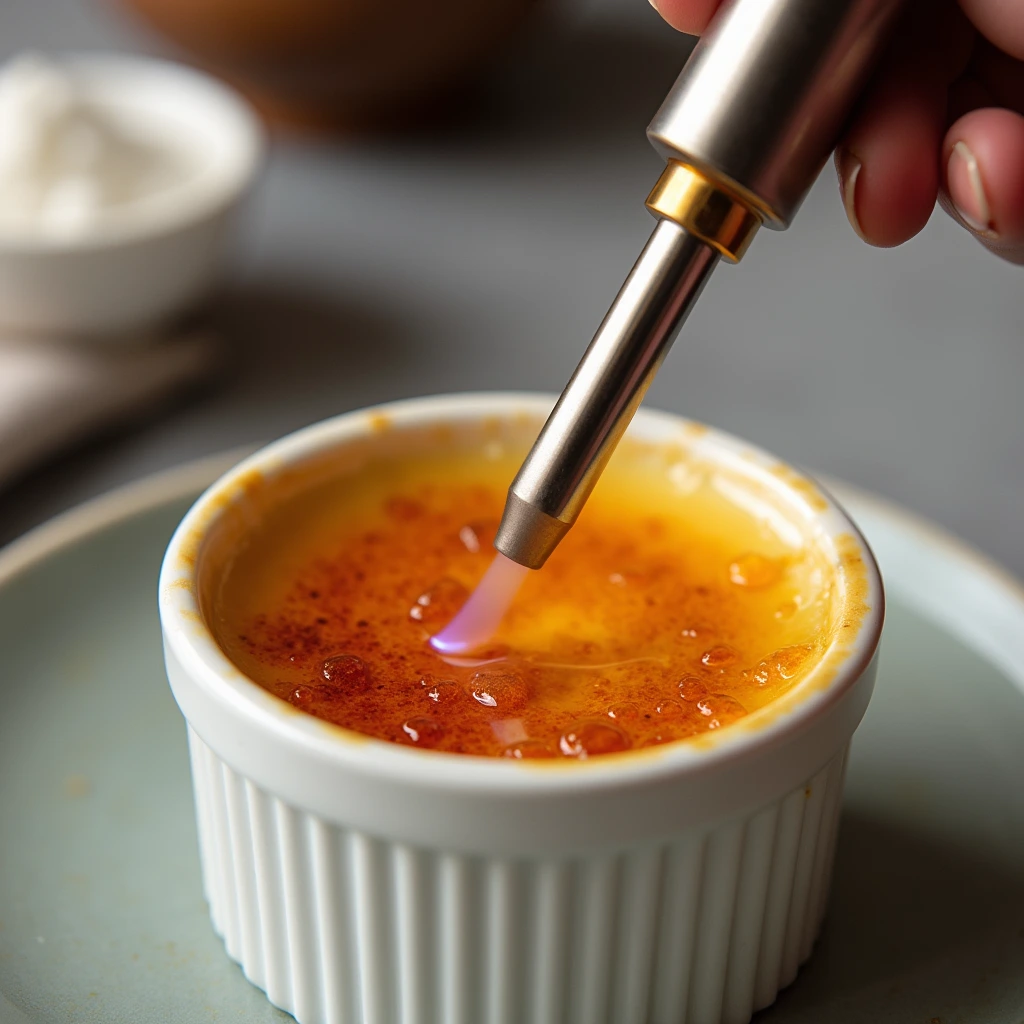There’s something magical about cracking through a perfectly caramelized brûlée topping—that satisfying crunch giving way to a smooth, creamy dessert underneath. Whether you’re making a classic crème brûlée, caramelized cheesecake, or even brûléed fruit, mastering this golden, glass-like sugar crust is the secret to elevating your desserts from simple to spectacular.
But how do you achieve that perfect brûlée—golden and crisp, without burning or becoming too soft? The key lies in the right sugar, the proper technique, and a little bit of heat control. Should you use a kitchen torch or broiler? What sugar works best for caramelization? And how can you avoid common mistakes like uneven browning or an overly thick crust?

In this guide, we’ll break down everything you need to know about making a flawless brûlée topping. From choosing the right sugar to mastering caramelization techniques, we’ll help you create that signature crisp layer that cracks beautifully under a spoon. Whether you’re a home baker or an aspiring pastry chef, this step-by-step guide will turn your desserts into show-stopping masterpieces. Get ready to ignite your torch and transform your treats with the irresistible magic of brûlée!
What is a Brûlée Topping?
A brûlée topping is a layer of caramelized sugar that creates a crispy, glass-like finish on desserts like crème brûlée. The word “brûlée” means “burnt” in French, referring to the process of heating sugar until it forms a crunchy crust. This topping provides a satisfying contrast to the soft, creamy texture of the dessert underneath.
The Art of Creating a Crispy Caramelized Layer
Making the perfect brûlée topping is a simple but careful process. Start by sprinkling a thin layer of sugar evenly over the dessert. Then, use a kitchen torch or broiler to heat the sugar until it melts, bubbles, and turns golden brown. The goal is to caramelize the sugar without burning it, creating a crisp crust that cracks easily when tapped. This balance of smooth and crunchy textures makes a brûlée topping a true delight.
Ingredients for a Brûlée Topping
Essential Ingredients
The main ingredient for a brûlée topping is sugar, usually plain white sugar. Its small crystals melt evenly and form a smooth, caramelized crust.
Choosing the Right Sugar Type
White sugar works best, but other types can be used for different flavors and textures. Brown sugar adds a rich, deeper taste but may not melt as evenly. Fine sugar melts faster and is good for beginners, while raw sugar gives a crunchier topping.
Additional Flavoring Options
To add a twist, mix spices like cinnamon or nutmeg with the sugar. A sprinkle of sea salt brings out the caramel flavor. You can also try using vanilla sugar or adding a little citrus zest for extra flavor. These options let you create a topping that’s unique and full of personality.
Tools Needed for Making Brûlée
Kitchen Torch vs. Broiler: Which to Choose?
A kitchen torch is the preferred tool for making a brûlée topping. It provides precise control, allowing you to evenly caramelize the sugar without heating the dessert underneath. This handheld tool is easy to use and delivers professional results.
A broiler, on the other hand, is a good alternative if you don’t have a torch. It can caramelize the sugar, but it may heat the dessert unevenly or require extra care to avoid burning. Broilers are less precise but still effective in a pinch.
Additional Tools for Preparation and Precision
To create a flawless brûlée, you’ll need a few other tools. A fine-mesh sieve ensures an even layer of sugar by removing lumps. A heatproof ramekin or shallow dish holds the dessert safely during caramelization. For an extra polished look, use a small offset spatula to evenly spread the sugar before heating.
With the right tools, you can achieve a perfect brûlée topping that’s crisp, golden, and irresistible.
Step-by-Step Guide to Making Brûlée Topping
Preparing the Custard or Dessert Base
Start by ensuring your dessert, such as crème brûlée, is fully chilled and set. This keeps the base creamy while the sugar caramelizes. Remove the ramekins from the refrigerator just before adding the topping.
How to Apply Sugar Evenly
Sprinkle a thin, even layer of granulated sugar over the surface of the dessert. For best results, use a fine-mesh sieve or your fingers to distribute the sugar evenly, covering the entire top without thick spots. Tap off any excess to avoid clumps.
Torch vs. Oven: Caramelizing the Sugar
If using a kitchen torch, hold it a few inches above the sugar and move it in a circular motion. Heat until the sugar melts, bubbles, and turns golden brown. Take care not to linger in one spot to avoid burning.
If using an oven broiler, place the ramekins on a baking sheet and set them under the broiler on high heat. Keep a close eye on the sugar as it melts and caramelizes, rotating the sheet if necessary for even browning.
Allow the caramelized topping to cool for a minute before serving to let it harden into a crisp layer. Enjoy cracking into it!
Tips and Tricks for a Perfect Brûlée
Avoiding Burnt Sugar
To prevent burning, keep a close eye on the sugar as you caramelize it. If using a torch, move it continuously in small circles to avoid overheating one area. With a broiler, watch closely and remove the dessert as soon as the sugar turns golden brown.
Achieving the Right Texture: Crunchy vs. Brittle
For a crunchy topping, use an even, thin layer of sugar. Thicker layers may become too hard or brittle. Using granulated sugar ensures a smooth, crackable surface. Avoid pressing the sugar into the dessert, as this can affect the texture.
How to Store and Serve Brûlée Desserts
Brûlée toppings are best enjoyed fresh for maximum crispness. If you need to prepare ahead, caramelize the sugar just before serving to maintain its crunch. Store uncooked custards in the refrigerator and bring them out right before adding the topping.
For serving, let the caramelized layer cool for a minute to harden. Serve immediately to showcase the delightful contrast between the creamy base and the crisp, caramelized crust.
Common Mistakes and How to Avoid Them
Over-Caramelizing or Burning the Sugar
Burning occurs when the sugar is exposed to too much heat or heat for too long. To avoid this, keep a kitchen torch moving in small circles rather than concentrating on one spot. If using a broiler, watch closely and remove the dessert as soon as the sugar turns golden brown.
Uneven Caramelization: Causes and Fixes
Uneven caramelization often results from an uneven layer of sugar. Always sprinkle sugar in a thin, even layer, using a fine-mesh sieve for better distribution. If using a broiler, rotate the baking tray for consistent exposure to heat.
Using the Wrong Sugar Type or Amount
Using the wrong sugar type, such as powdered sugar, can lead to clumps or uneven melting. Stick to granulated white sugar for the best results. Avoid using too much sugar, as it can form a thick, overly hard crust. A thin layer works best for a crisp yet delicate topping.
Storage Issues: Keeping the Topping Crisp
Brûlée toppings lose their crunch when stored for too long. To maintain crispness, caramelize the sugar just before serving. If storing desserts with a brûlée topping, avoid refrigeration as it can soften the caramel. Use airtight containers if short-term storage is necessary.
Creative Variations on Brûlée Toppings
Infused Sugars for Unique Flavors
Elevate your brûlée topping by using infused sugars. For example, vanilla sugar adds a warm, aromatic touch, while citrus-infused sugar brings a bright, zesty flavor. You can create these by mixing sugar with vanilla beans or citrus zest and allowing it to sit for a few days.
Using Alternative Sweeteners
Experiment with alternative sweeteners like coconut sugar or turbinado sugar. Coconut sugar offers a caramel-like flavor with a hint of richness, while turbinado sugar provides a slightly crunchier texture. These options can add depth and complexity to your topping.
Adding Spices for a Twist
Enhance your brûlée with spices such as cinnamon, nutmeg, or even a pinch of cardamom. Mix the spices into your sugar before caramelizing for a subtle yet distinct flavor boost that complements creamy dessert bases.
Layering Brûlée Toppings with Fruits or Chocolate
Take your brûlée to the next level by layering thinly sliced fruits like strawberries or bananas under the sugar before caramelizing. For a more decadent variation, sprinkle a fine layer of grated chocolate over the sugar to create a chocolate-caramel crust. These additions introduce new textures and flavors to the classic brûlée experience.
The Science Behind Caramelization
How Sugar Caramelizes: The Maillard Reaction vs. Caramelization
Caramelization occurs when sugar is heated to a high temperature, breaking down the sugar molecules and transforming them into new compounds that give it a golden-brown color and rich, toasty flavor. Unlike the Maillard reaction, which involves proteins and sugars and produces browning at lower temperatures (like when searing meat), caramelization strictly refers to the breakdown of sugars at high heat, typically above 320°F (160°C). Both processes add depth of flavor, but caramelization is responsible for the sweet, rich flavor we associate with desserts.
Why Temperature Control is Crucial
Temperature control is essential when caramelizing sugar, as it directly affects the outcome. Too low of a heat will result in uneven melting and a syrupy texture, while too high of a temperature can burn the sugar, making it bitter and hard. For the perfect brûlée topping, sugar needs to reach a temperature of around 340°F (170°C) to form that ideal crunchy, golden layer without burning.
The Role of Sugar Crystals in Achieving a Smooth Crust
The size and structure of sugar crystals play a crucial role in achieving a smooth, crackable crust. Granulated sugar, with its small and uniform crystals, melts evenly and forms a smooth caramel layer when heated. Larger crystals, like raw or turbinado sugar, may create a rougher, less uniform texture, affecting the crispness and consistency of the brûlée topping.
FAQs About Brûlée Toppings
What’s the Best Sugar for Brûlée?
Granulated white sugar is the best choice because it melts evenly and caramelizes smoothly. Alternatively, superfine sugar can be used for a thinner, faster-melting layer, while brown sugar adds a rich flavor, though it may not caramelize as evenly.
Can You Make Brûlée Without a Torch?
Yes, you can! If you don’t have a torch, a broiler is a great alternative. Simply place the dessert under the broiler and watch closely to prevent burning as the sugar caramelizes.
How Do You Fix a Brûlée That’s Too Soft?
If the topping turns out too soft, you can reapply heat with a torch or broiler. This will help the sugar caramelize fully, and then it can cool and harden properly.
What Desserts Are Best for a Brûlée Topping?
While crème brûlée is the classic option, other desserts work just as well. For example, rice pudding, cheesecake, custards, or even fresh fruits like grapefruit pair beautifully with a brûlée topping.
How Far in Advance Can I Brûlée a Topping?
Ideally, brûlée the topping just before serving. Otherwise, the caramel may soften or lose its crunch over time.
Is It Safe to Use a Torch at Home?
Yes, it is safe as long as you follow the instructions. For instance, keep flammable items away, use the torch in a well-ventilated area, and handle it with care.
Mastering a brûlée topping
Mastering a brûlée topping transforms ordinary desserts into extraordinary culinary experiences. The crispy, caramelized layer adds not only a delightful crunch but also a touch of elegance to any dish. The contrast between the smooth, creamy base and the brittle topping creates a harmonious blend of textures that elevates desserts to a new level.
Learning to make a perfect brûlée topping also showcases your skill and attention to detail, turning simple treats like custards, cheesecakes, or even fresh fruit into restaurant-quality delights. The process itself is satisfying, from the artful sprinkling of sugar to the mesmerizing transformation under the torch or broiler.
By mastering this technique, you gain a versatile tool in your culinary repertoire. Whether impressing guests at a dinner party or indulging in a special treat for yourself, a flawless brûlée topping adds an unforgettable finishing touch to any dessert.
More
For additional resources on creating and mastering a brûlée topping, check out the variety of recipes and cooking techniques on Quickly Taste. For example, their Crab Brûlée Recipe offers a unique twist on traditional brûlée with a savory approach. You can also explore sweet options like their Lemon Tiramisu Recipe to experiment with diverse desserts.
If you’re looking for more guidance on tools and techniques, Serious Eats provides in-depth tutorials on caramelization and tips for using kitchen torches effectively. For those without a torch, Food52 outlines alternative methods like using a broiler for perfect results.
Whether you’re a beginner or a seasoned cook, these resources ensure you have everything you need to elevate your desserts with professional-quality brûlée toppings.
Related Posts
- How to Make Easy Cool Whip Candy at Home
- How to Make Peach Pie Cruffins: A Summer Dessert Masterpiece
- How to Make the Perfect Savory Cabbage Beef Bake
- How to Make Lazy Girl Pecan Pie Bars
- How to Make Million Dollar Lasagna: The Richest, Creamiest Lasagna You’ll Ever Eat
- How to Make a Drunken Papa Smurf Cocktail (Step-by-Step Recipe)







